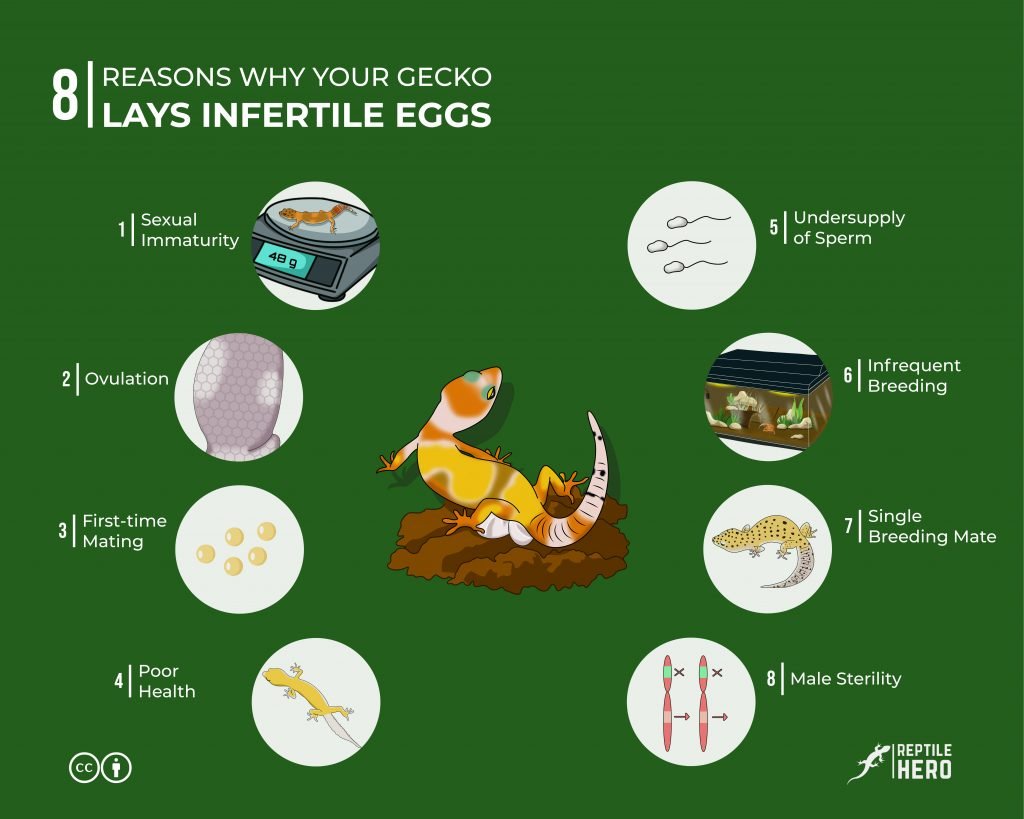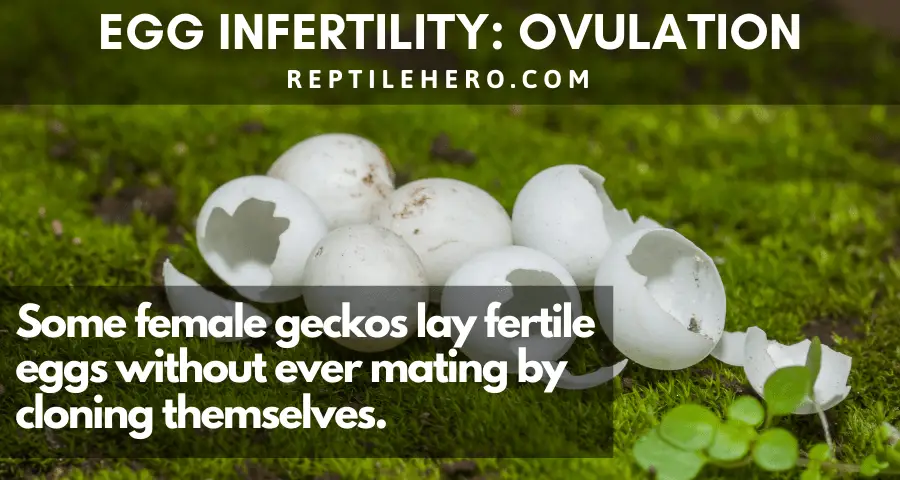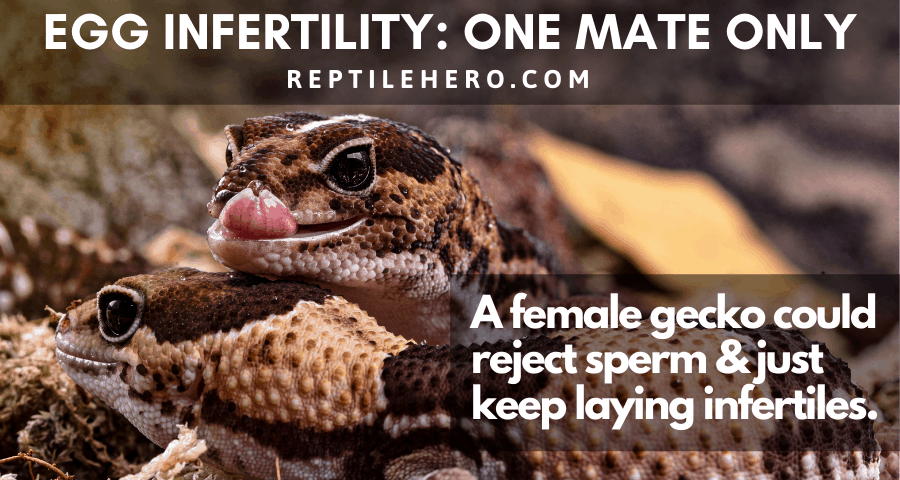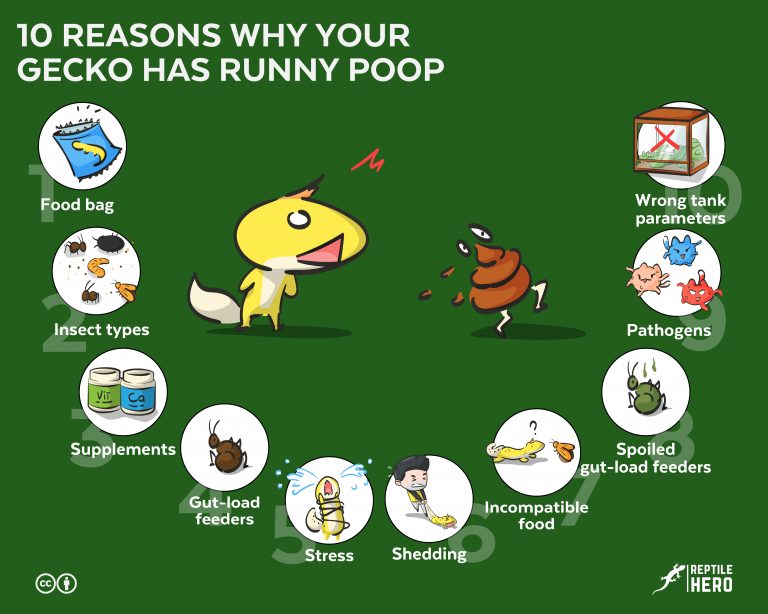8 Reasons Why Your Gecko Lays Infertile Eggs [and 5 Tips]
Finally getting your girl to lay an egg after fattening her up and finding a male to breed her with is absolutely exciting. Unfortunately, they don’t always hatch making it tempting for others to cut it open just in case. And wouldn’t you know it – it’s empty and infertile.
The 8 factors that cause gecko egg infertility: 1) sexual immaturity, 2) ovulation, 3) first-time mating, 4) poor health, 5) undersupply of sperm, 6) infrequent breeding, 7) single breeding mate, and 8) male sterility. All aforementioned factors must be properly addressed to increase egg fertility rates.
Now, don’t wait for me to egg you on to continue reading so you can learn why geckos lay infertile eggs.

Why aren’t all Gecko Eggs Fertile?
Regardless of whether you’re looking to breed the geckos in your care, feeling frustrated by all the bad eggs you’ve been getting, or shocked to find an odd egg in your female gecko’s enclosure, you should learn more about your gecko’s reproductive health. Here are the 8 factors I’ve found which cause the creation of infertile gecko eggs.
#1 – Sexual Immaturity
Long-time breeders usually base the sexual maturity of geckos on two criteria: age and weight. A gecko younger than 1 year or lighter than 50 grams might struggle to produce eggs as it might not have reached its sexual maturity.
Some prefer to determine the readiness of their geckos for breeding based solely on their age while others like to rely on weight monitoring. But I think it’s best to check for both.
Different species reach sexual maturity [1] at different life stages. The common house gecko, are old enough to reproduce 6 months after hatching. Leopard and day geckos, however, would need to be at least 1 year old to be able to reproduce.
However, I wouldn’t advise you to let juvenile geckos breed as soon as they’re considered fertile because another big part that determines sexual maturity is their body mass. Again, different species are good for breeding when they reach different weights which are considered healthy for them.
For example, leopard geckos would need to be at least 50 grams while crested geckos should be at least 30 grams. And it’s just one of the many differences you need to consider between species before deciding which one to take home with you.
This is particularly important for the female geckos you are planning to breed because they will need a lot of resources – which they get from a good bulking-up diet – to be able to produce a fertile egg. So, many hobbyists intentionally fatten up their females before introducing them to a male. This also ensures that neither will act too aggressively and bully the other.
In fact, most breeders nowadays wait until both their male and female are at least 2-year-old adults and their female is on the plumper side of the spectrum before pairing them up for the season. Doing otherwise would lead to high chances of egg infertility and possible complications.
#2 – Ovulation

Female gecko can produce eggs by themselves without a male gecko as part of the ovulation process. However, such eggs will be clearly unfertile similar to what happens to many other animals (such as chickens).
Like women and many other female animals, geckos produce eggs regularly once they reach the stage in life when they are considered sexually mature. This normal body process is called ovulation. You can tell this is happening when your female has one or two round pinkish masses forming in its abdomen.
They may either reabsorb this egg while still in their bodies or lay it. After laying a clutch of eggs without breeding, you can expect them to do three very peculiar things – eat it [2], watch over it, or completely ignore it. Plenty of my friends also share that their geckos usually lay duds in weird places like their water dish or on a fake plant.
If you’re planning to never house it with a male and breed it, it could lay an infertile egg every once in a while or never. Once they’ve been bred once, they could do it monthly or stop producing slugs altogether.
So yes, they can lay eggs even if they’ve never been introduced to a male before. However, these are certainly infertile because no sperm was present to fertilize them. Think of the chicken eggs we cook and eat. It’s basically like that – it has the yolk, egg white, and all that jazz except for a developing embryo.
Well, that is unless they are capable of parthenogenesis: a type of sexual reproduction wherein a single female can create clones of itself without needing a male to make it fertile. Mourning geckos are particularly known as one of the few parthenogenetic species. Cresties have also displayed this “virgin birth” phenomenon in a few rare cases.
#3 – First-time Mating
The very few first times a gecko produces eggs, even in case of a proper mating, the eggs might still be infertile due to its initial inability to handle its body resource correctly when producing an egg.
Rarely can you perfect anything at your first try even if you have the confidence of succeeding at a task. And I guess this is true for geckos trying to lay good and healthy eggs for the very time as well.
Although there are only a few studies [3] to prove that this theory has some truth to it, I think it is still quite a valid assumption. Hopefully, more researchers delve into the topic of gecko reproduction so regular keepers like us are confident that we’re doing proper husbandry.
So the theory is: because geckos have no previous experience to base their success in creating a fertile egg before, they may not know how much of their own reserves to put into producing eggs and naturally lay obviously deformed and imperfect bad eggs.
Experienced keepers and breeders commonly also think that this may be the case. Their first few clutches usually had a dud. Some even had zero fertile eggs during those times. So if you’re attempting to breed your precious geckos for the first time, don’t be surprised if you get a couple of bad eggs.
However, as they grow older and gain more experience in making good eggs, they tend to stop producing slugs. The rates of fertility and successful hatching of their eggs usually increase with time and practice. So don’t feel discouraged if you’re getting infertile eggs from your gecko who we could pretty much consider a young adult.
As the saying goes, the third time’s the charm.
#4 – Poor Health
Deficiency in calcium and vitamin D3, in particular, will increase the likelihood of producing bad eggs. Other causes might include being underweight and lack of macronutrients in the diet.
If you’re female isn’t healthy and is suffering from any sort of disease, I’m sure it’s already really hard for her to keep herself alive and breathing. So imagine just how incredibly difficult it would be for her to keep trying to sustain another life or two inside her (as geckos normally produce two eggs in a clutch).
So, they need additional supplementation when you want to introduce them to males for mating.
Moreover, although it’s good to fatten up your female geckos before the breeding season with a few fatty worms or a rare serving of meat and eggs that’s jam-packed with protein and many other macronutrients, be careful not to overfeed them.
Obese gravid geckos are at an increased risk of experience egg-binding an infertile clutch. The difficulties and complications they have to endure during dystocia may render them completely infertile forever.
And if you stop for a minute to really think about it, producing eggs is already a strenuous and taxing activity in and of itself for even the healthiest female. So just think about how much more exhausting and dangerous that would be for a gecko that’s not physically fit and has numerous nutritional deficiencies.
#5 – Undersupply of Sperm
Female geckos might lay infertile eggs due to insufficient levels of sperm left in their bodies’ reservoir.
Interestingly, geckos are capable of storing functional sperm from a single instance of mating for more than a year [4]. This ability is referred to as amphigonia retarda and some other reptile species are capable of retaining sperm for up to 7 years.
Who knows, maybe there are certain geckos species capable of doing it for many years as well but it just hasn’t been documented by scientists yet.
However, that doesn’t mean they’re capable of keeping sperm forever to continue producing fertile eggs without ever needing to breed again after their first time. They will inevitably run out of retained sperm and they will need to be introduced to a male for breeding again.
So if you’re female has consistently been laying fertile eggs but suddenly only produced duds time after time, it’s not necessarily a bad sign. They might just need more sperm.
#6 – Infrequent Breeding
Geckos paired up for the breeding season that are housed in different vivariums are less likely to produce fertile eggs due to decreased chances of repeated copulation.
When you’re housing the male and female geckos you are planning to breed in different vivariums and immediately move either back to their enclosures right after they mate for a single time, you are increasing your chances of getting slugs.
Of course, I know some keepers aren’t exactly looking to have tons of new soft-bellied babies so they don’t cohabitate their geckos. However, your female gecko will need to mate more than once a month during the season if you want them to produce more fertile eggs. Some successful breeders I know get good eggs every single time because they house their gecko couples together.
The exact mechanisms behind having increased fertilization success after repeated copulation is still unclear however, I think that cryptic female choice [5] definitely plays a significant role in such situations.
Basically, even if your male is definitely fertile if your female doesn’t think his sperm is good enough to ensure her babies’ chances at a good and healthy life, she will not let him fertilize her eggs no matter how many times they mate. Nevertheless, them being choosy is only them ensuring that the eggs they spend so much time and effort producing are going to thrive even after hatching.
#7 – Single Breeding Mate

Research has shown that female geckos which were bred once or twice with only one male produced significantly more infertile eggs compared to those which were bred once with two different males.
The common practice of only giving females a single male to breed with could actually be another possible reason as to why geckos have low fertility rates. Here’s the deal: most reptiles aren’t known for being monogamous creatures so we shouldn’t force them to be.
Yes, they could be extremely territorial and possessive of their mate during the breeding season but we have yet to see evidence of them intentionally mating with a single gecko of the opposite sex in the wild.
In fact, aside from increasing rates of egg fertility by about 6 times scientists [6] have found that when a female gecko mates multiple times with different males, they also produce more clutches and better eggs overall compared to a female who only mated once with a single breeding mate.
Of course, the cryptic female choice could also possibly explain this as your little lady friend has higher chances of receiving sperm that meets her standards and as a result, produce healthier and hardier eggs. Think of it like you would a raffle; the more entries you have, the greater your chances of winning are.
#8 – Male Sterility
A female gecko will continuously produce infertile eggs despite repeated breeding if the male gecko it is paired up with is sterile.
If you aren’t seeing any success in getting fertile eggs from any of the female geckos you have that you know is 100% fertile, the problem may be because of your male. Male sterility or infertility in geckos is not as common as most hobbyists think but it definitely does happen.
There’s not much information on what exactly causes sterility in male geckos of different species. It could be because of defects they had when they’re still developing inside their eggs or because they are suffering from an illness.
In certain species, however, it’s been shown some males are born infertile due to parthenogenesis [7] and crossbreeding [8].
With parthenogenesis, since mourning geckos reproduce primarily through asexual means, males have lost their need to fertilize the egg and became sterile over time. Crossbreeding, on the other hand, pretty much causes a 50% chance of sterilization in the males of the hybrid thanks to Haldane’s rule – infertility in either animal to be crossbred will likely cause infertility in males and not females [9].
5 Practical Tips to Raise Gecko Egg Fertility
Now that you know what factors cause gecko egg infertility, I’m sure you want to know how you could possibly increase fertility rates especially if you really want to breed your cute little reptile buddies. Here’s how:
- Give your females more vitamins and supplements before and during the breeding season.
- Keep them on a healthy diet to bulk-up and have enough reserves to produce good eggs.
- Add a dedicated lay box in their tanks so good eggs don’t get contaminated and become moldy duds.
- Let females mate more frequently and with more than one male. And keep in mind that it may take them weeks or months before finally laying an egg after copulation.
- House your couples in the same tank permanently or for longer periods.
How to Tell if Gecko Eggs are Fertile
Fertile gecko eggs are usually chalky white and a bit firm stale marshmallow consistency while infertile geckos are almost always wonky-looking discolored eggs that feel like squishy gels with water inside.
But that is not always the case. Sometimes, bad gecko eggs could look totally fine for weeks then suddenly start molding, collapsing, discoloring, leaking, and stinking.
So it’s not advisable to determine egg fertility based on physical appearance alone. A sure-fire way to know whether you have a good or bad gecko egg is to check by candling. It is a method used on bird and reptile eggs to look for signs of life – veining and embryo development. It’s best to do this one week after being laid and every other week or so after.
For a light source, you can of course use a candle as the name implies but it’s safer to use a flashlight, like a LED penlight or even the torchlight at the back of your phone – you won’t have to worry about accidentally roasting it. Hold it under the eggs in a dark room to better see what’s inside the egg. To avoid over-handling the eggs and crushing them, you could also just leave them as they are in their incubator and shine light into it from the top or sides.
Fertile eggs usually have a spider-web of veins forming all around the egg in addition to having what we keepers like to call “the red cheerio of life”. Honestly, though, I think Target’s logo is a better comparison. Early on in the embryo development, this may look more like just a tiny red dot but it will grow as the days pass. It also has a pinkish shade to it when lit up. And as it develops, it may appear more and more opaque because the baby inside will be steadily growing.
If you’re having a hard time trying to visualize all of that, watch this picture to get a better picture of what you should expect to see when candling gecko eggs:
Infertile eggs, on the other hand, shine just yellow all throughout the inside with no other defining features whatsoever. However, if you candle a freshly laid egg, a fertile egg may initially look completely yellow as well. So it’s better to incubate all eggs even though you have a hunch that some may be infertile – incubate until there’s no debate.
In any case, once you notice that your lady gecko has started digging around her substrate, eating less and less, and acting lethargic, check her for ovulation. If she is indeed forming eggs in her soft and cold belly, make sure to help her put on some weight and prepare a lay box for her. Regardless of whether the egg is infertile or fertile, your female will lay it. Having a good dedicated laying area will decrease her chances of retaining the egg so prepare it in advance.
3 Ways To Deal With Unwanted Gecko Eggs
Eggs can be a gecko keeper’s greatest dream or worst nightmare. So if your lovely little gecko lady suddenly throws you in for a loop by giving you gecko eggs – fertile or not – that you neither expected nor wanted, it’s totally understandable that you’d want to take it off your hands.
Below are 3 methods you should consider doing when you can’t or don’t want to keep gecko eggs:
- Give them away. Not everyone has the funds and time needed for incubating gecko eggs, let alone take care of multiple geckos, and it may take a few weeks before you can determine whether an egg is indeed fertile. In such cases, find a local breeder or pet shop who can take care of it for you.
- Offer it as food. I know this might sound cruel but geckos of various species (and many other reptiles) have been documented to eat their eggs – at times even live hatchlings – in the wild. You can offer it to your female who laid it so it can gain back the nutrients she lost during production or give it to other reptiles you may have in the family.
- Chuck it out. If you’ve confirmed that it’s 100% infertile or you can’t do either of the two options I’ve already mentioned, freeze it for at least 1 day to make sure it doesn’t just suddenly hatch if you can’t ensure infertility and then dispose of it.
Takeaways
The 8 reasons for gecko egg infertility are as follows: sexual immaturity, ovulation, first time, poor health, undersupply of sperm, infrequent breeding, single breeding mate, and male sterility. To increase egg fertility, properly address the aforementioned issues.
Infertile eggs appear completely yellow when candled. Fertile eggs will appear pink with dark veins and a red cheerio on it when it’s candled.
If you don’t have the money, time, and space to care for new geckos, give your geckos’ eggs to breeders, feed them to your reptile, or freeze and dispose of them.
Sources
[1] https://animaldiversity.org/search/?q=gecko&feature=INFORMATION
[2] https://www.vin.com/apputil/content/defaultadv1.aspx?pId=12886&id=7054661&print=1
[3] https://edepot.wur.nl/320482
[6] https://onlinelibrary.wiley.com/doi/abs/10.1111/j.1439-0310.2008.01495.x
[7] https://pubmed.ncbi.nlm.nih.gov/18513934/
[8] https://journals.plos.org/plosone/article?id=10.1371/journal.pone.0143630




![5 Steps To Calm Down A Gecko [+4 Simple Tips]](https://www.reptilehero.com/wp-content/uploads/2021/12/calm-down-gecko-cc-768x614.jpg)
![Do Leopard Geckos Need Heat Mats? [Myth or Truth]](https://www.reptilehero.com/wp-content/uploads/2022/03/does-gecko-needs-heat-mats-cc-768x614.jpg)
![Do Geckos Fart? [4 Potential Reasons]](https://www.reptilehero.com/wp-content/uploads/2021/05/why-geckos-fart-cc-768x614.jpg)